war
Steal This Book
“Leaflets, posters, newsletters, pamphlets and other printed matter are important to any revolution. A printing workshop is a definite need in all communities, regardless of size. It can vary from a garage with a mimeograph machine to a mammoth operation complete with printing presses and fancy photo equipment. With less than a hundred dollars and some space, you can begin this vital service. It’ll take a while before you get into printing greenbacks, phony identification papers and credit cards like the big boys, but to walk a mile you must start with one step as Gutenberg once said.”
...
“Food conspiracies, bust trusts, people’s clinics and demonstrations are all part of the new Nation, but if asked to name the most important institution in our lives, one would have to say the underground newspaper. It keeps tuned 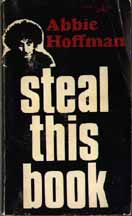 in on what’s going on in the community and around the world. Values, myths, symbols, and all the trappings of our culture are determined to a large extent by the underground press. Each office serves as a welcome mat for strangers, a meeting place for community organizers and a rallying force to fight pig repression. There are probably over 500 regularly publishing with readerships running from a few hundred to over 500,000. Most were started in the last three years. If your scene doesn’t have a paper, you probably don’t have a scene together.”
in on what’s going on in the community and around the world. Values, myths, symbols, and all the trappings of our culture are determined to a large extent by the underground press. Each office serves as a welcome mat for strangers, a meeting place for community organizers and a rallying force to fight pig repression. There are probably over 500 regularly publishing with readerships running from a few hundred to over 500,000. Most were started in the last three years. If your scene doesn’t have a paper, you probably don’t have a scene together.”
...
“A heavier scene than even the high schools exists in No-No Land of the military. None-the-less, against incredible odds, courageous G.I.’s both here and overseas have managed to put out a number of underground newspapers. If you are a G.I. interested in starting a paper, the first thing to do is seek out a few buddies who share your views on the military and arrange a meeting, preferably off the base. Once you have your group together, getting the paper published will be no problem. Keeping your staff secret, you can have one member contact with someone from a G.I. coffee house, anti-war organization or nearby underground newspaper. This civilian contact person will be in a position to raise the bread and arrange the printing and distribution of the paper. You can write one of the national G.I. newspaper organizations listed at the end of this section if you are unable to find help locally. The paper should be printed off the base. Government equipment should be avoided.”
...
“Under FCC Low Power Transmission Regulations, it is legal to broadcast on the AM band without even obtaining a license, if you transmit with 100 milliwatts of power or less on a free band space that doesn’t interfere with a licensed station. You are further allowed up to a 12-foot antenna or the use of carrier-current transmission (regular electric wall outlets). Using this legal set-up, you can broadcast from a 2 to 20 block radius depending on how high up you can locate your antenna and the density of tall buildings in the area.”
...
Free food, housing, education, and independent media. Shoplifting, pipe bombs, medical care, draft counseling... and graphic design.
It’s all there in the hipster slang of 1970. While downloading the complete Steal This Book as one big 413 Kb HTML file, read a little about its provenance.
The title joke still makes me laugh. Steal this book about destroying capitalism. But, while some items in the book are still relevant to movement building and perhaps real social change, others seem more like cheap thrills than liberation. 30 years later, Hoffman’s catalogue of techniques of resistence reads as a vision of a life of struggle. The introduction breezes through a snapshot of the ills of America, but get your nuanced political and economic analysis elsewhere — this is just a practical guidebook. Perhaps for those without a nuanced political or economic analysis? “The purpose of part two is not to fuck the system, but destroy it.” By fighting violence and theft with violence and theft? And then what?
Found via Boing Boing.
American Concentration Camps

Blamed for an attack on America, non-white Americans and residents of foreign descent had become so hated that in February 1942 the President ordered their arrest and detention at “relocation centers” around the country. 110,000 men, women, and children were removed from their homes, rounded up at gun point, and locked up for the next three years.
From a Web site on Owens Valley History, the site of the Manzanar detention center:
“Two-thirds were first-generation American citizens. They lived in American cities, attended American schools, and thought of themselves as Americans... They were removed from their homes, schools, and businesses, and brought to Manzanar and nine other camps like it.... A few were second-generation Americans.... Neither they nor their parents had ever known any other life than their life in the United States.
Almost a third of the prisoners were Japanese citizens, resident aliens by definition of the U.S. immigration law.... All of this group had lived in the United States at least eighteen years, since American borders were closed to Japanese immigrants in 1924. All had been specifically barred from applying for American citizenship. The right to become an American citizen was not allowed to the Japanese until 1952, when quotas were introduced.”
The Library of Congress Web site features a collection of 244 photographs of Japanese-American internment at Manzanar taken by reknown landscape photographer Ansel Adams. Depicted are scenes of daily life, agricultural scenes, sports and leisure activities, and portraits of the detainees. Browse via the subject index or the thumbnail view.
From the Library page about the collection:
“In 1943, Ansel Adams photographed the Manzanar War Relocation Center at the suggestion of its director, his good friend and fellow Sierra Club member, Ralph Merritt. Adams wanted to contribute to the war effort while at the same time show the loyalty of the Japanese-Americans interned at Manzanar... In 1944, some of these images were published in Adams’ book Born Free and Equal. The book had a limited circulation, perhaps due to the political climate of war-time America. When offering the collection to the Library, Adams said in a letter, ‘All in all, I think this Manzanar Collection is an important historical document, and I trust it can be put to good use...The purpose of my work was to show how these people, suffering under a great injustice, and loss of property, businesses and professions, had overcome the sense of defeat and despair by building for themselves a vital community in an arid (but magnificent) environment.’”
The internment camps were small planned communities built with volunteer, contract, and forced labor on the site of a ghost town.
“The center was located at the former farm and orchard community of Manzanar. Founded in 1910, the town was abandoned when the city of Los Angeles purchased the land in the late 1920s for its water rights. The Los Angeles aqueduct, which carries Owens Valley water to Los Angeles, is a mile east of Manzanar.”
In addition to vital necessities of food and shelter, the camp had its own school, church, factories, hospital, and even a local paper. See this essay for details on the design and operations of the camp.
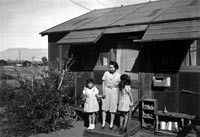 40 years after the closing of the camps, the United States government conceded that the relocation was based on racial bias rather than on any true threat to national security. 50 years later in 1992, President Bush offered reperations and an apology.
40 years after the closing of the camps, the United States government conceded that the relocation was based on racial bias rather than on any true threat to national security. 50 years later in 1992, President Bush offered reperations and an apology.
Congress established the Manzanar National Historic Site, containing 550 acres, on March 3, 1992. It is currently administered by the National Park Service, under the U.S. Department of Interior. See the Park Service Web site.
Nearly 60 years after the war, Yoshie Hagiya, age 77, Oxnard High class of 1942, received her school’s valedictorian honors.
Center for the Study of Political Graphics
“There has never been a movement for social change without the arts — theatre poetry, music posters — being central to that movement. Political posters in particular are powerful living reminders of struggles worldwide for peace and justice. Communication, exhortation, persuasion, instruction, celebration warning: graphic art broadcasts its humanity through bold messages and striking iconography.
The Center for the Study of Political Graphics (CSPG) is a nonprofit, tax-exempt educational archive that collects, preserves, documents, and exhibits domestic and international posters relating to historical and contemporary movements for peace and social justice....
The archive includes more than 35,000 posters produced in a staggering array of visual styles and printing media, dating from the Russian Revolution to the present. University, museum, and public collections of this material are rare, and because those that do exist are seldom accessible to the public, CSPG’s commitment to continually exhibiting this rich visual and social history is so critical....
The Center was recently awarded a major grant from the Getty Grant Program to implenient a state-of-the-art electronic cataloging system designed to make the collection even more accessible.”
I do hope “more accessible” includes publishing more of their collection online. On the CPSG site, the exhibit Presidential Rogues Gallery: Satrical Posters 1960 - Present features a mere 11 images. The Sixties Project has published another of the CPSG’s exhibits online. Decade of Protest: Political Posters from the United States, Cuba and Viet Nam 1965-1975 features 67 posters that were shown at the Track 16 Gallery in Santa Monica in 1996.
Though the center limits its collection to posters from peace and justice movements, a thorough study of propaganda technique would also include material from a right-wing point of view. Movements for peace and justice would also do well not to ignore grassroots conservative movements, their history and political graphics.
The image above is copyright 1971 by the Committee to Help Unsell the War, “a coalition of over 30 advertising agencies.”
The Art of the FBI
The FBI’s “counter intelliegence” program COINTELPRO was created in 1956 to neutralize political dissidents in the United States. Although the FBI’s COINTELPRO’s officially ended in 1971, there have been many examples of counterintelligence-type operations against political dissidents since. The 1976 investigation led by Senator Frank Church officially brought COINTELPRO’s mission to light:
“‘to expose, disrupt, misdirect, discredit, or otherwise neutralize’ such groups and their ‘leadership, spokesmen, members, and supporters.’ The larger objectives were to ‘counter’ their ‘propensity for violence’ and to ‘frustrate’ their efforts to ‘consolidate their forces’ or to ‘recruit new or youthful adherents.’ Field offices were instructed to exploit conflicts within and between groups; to use news media contacts ridicule and otherwise discredit groups; to prevent ‘rabble rousers’ from spreading their ‘philosophy’ publicly; and to gather information on the ‘unsavory backgrounds’ of group leaders.
One of their techniques was the use of “black propaganda,” bogus information that conceals or fakes its source. This included faked letters, poems, and satirical comic books to pit activists against one another.
Stay Free Magazine’s article “Fake Letters and Bad Poetry: Highlights from the FBI’s Secret War on Dissent” lists several examples:
Coloring Books
Previously mentioned here, the Black Panther Coloring Book was designed by the FBI to appear as if created by the Panthers. The books contained inflamatory pictures, some of which featured young black kids shooting pigs dressed as policemen. From the Church report:
 “One of the Bureau’s prime targets was the BPP’s free ”Breakfast for Children” program, which FBI headquarters feared might be a potentially successful effort by the BPP to teach children to hate police and to spread ‘anti-white propaganda.’ In an admitted attempt ‘to impede their contributions to the BPP Breakfast Program,’ the FBI sent anonymous letters and copies of an inflammatory Black Panther Coloring Book for children to contributors, including Safeway Stores, Inc., Mayfair Markets, and the Jack-In-The-Box Corporation.
“One of the Bureau’s prime targets was the BPP’s free ”Breakfast for Children” program, which FBI headquarters feared might be a potentially successful effort by the BPP to teach children to hate police and to spread ‘anti-white propaganda.’ In an admitted attempt ‘to impede their contributions to the BPP Breakfast Program,’ the FBI sent anonymous letters and copies of an inflammatory Black Panther Coloring Book for children to contributors, including Safeway Stores, Inc., Mayfair Markets, and the Jack-In-The-Box Corporation.
On April 8, 1976 in Executive Testimony a former member of the BPP Central Steering Committee stated that when the coloring book came to the attention of the Panther’s national leadership, Bobby Seale ordered it destroyed because the book ‘did not correctly reflect the ideology of the Black Panther Party.’”
Posters and Flyers
Paul Krassner writes in “The FBI and Me — An American Story”:
“In 1969, the FBI attempt to assassinate my character escalated to a more literal approach. I discovered this, not in the file kept by Cointelpro, the FBI’s counterintelligence program, but as part of a separate project calculated to cause rifts between the Jewish and black communities.
The FBI produced a ‘WANTED’ poster featuring a large swastika. In the four square spaces of the swastika were photos of Yippie leaders Abbie Hoffman and Jerry Rubin, SDS leader Mark Rudd, and myself. Under the headline ‘Lampshades! Lampshades! Lampshades! Lampshades!’ the copy referred to ‘the only solution to Negro problems in America’ as being ‘the elimination of the Jews,’ listed in the following order: ‘All Jews connected with the Establishment. All Jews connected with Jews connected with the Establishment. All Jews connected with those immediately above. All Jews except those in the Movement. All Jews in the Movement except those who dye their skins black. All Jews. (Look out, Abbie, Jerry, Mark and Paul!)’
The flyer was approved, once again, by [Kartha] DeLoach and [William] Sullivan [J. Edgar Hoover’s top two assistants]: ‘Authority is granted to prepare and distribute on an anonymous basis to selected individuals and organizations in the New Left the leaflet submitted..,. Assure that all necessary precautions are taken to protect the Bureau as the source of these leaflets [which] suggest facetiously the elimination of these leaders [to] create further ill feeling between the New Left and the black nationalist movement....’
And if some overly militant African American had obtained that flyer and ‘eliminated’ one of those ‘New Left leaders who are Jewish,’ the FBI’s bureaucratic behind would be covered: ‘We said it was a facetious suggestion, didn’t we?’”
Cartoons
 In their chapter on COINTELPRO and the New Left in The COINTELPRO Papers: Documents from the FBI’s Secret Wars Against Dissent in the United States, Ward Churchill and Jim Vander Wall reproduce an FBI memo [pages 1, 2] which lays out the Bureau’s plan to disrupt the New Left:
In their chapter on COINTELPRO and the New Left in The COINTELPRO Papers: Documents from the FBI’s Secret Wars Against Dissent in the United States, Ward Churchill and Jim Vander Wall reproduce an FBI memo [pages 1, 2] which lays out the Bureau’s plan to disrupt the New Left:
“Consider the use of cartoons, photographs, and anonymous letters which will have the effect of ridiculing the New Left. Ridicule is one of the most potent weapons which we can use against it.”
A further memo [pages 1, 2] details the plan to disrupt Students for a Democratic Society at Temple University through the use of cartoons, pamphlets and anonymous letters.
The cartoon displayed here was produced and distributed by the Philadelphia FBI office as part its plan to subvert SDS at Temple University. The caption, in a parody of the rhetoric of Sen. Joseph McCarthy reads, “I have in my hand a list of 200 names of people who don’t advocate the violent overthrow of the government.”
Mail Art
From Stay Free:
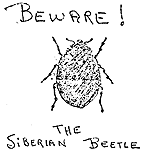 “The FBI believed that many New Left leaders had a weakness for spiritualist mumbo-jumbo, so a 1968 memo suggested mailing them anonymous cartoons such as the one pictured here. Subsequent mailings (from increasingly closer locations) could say ‘The Siberian Beetle is Black’ or ‘The Siberian Beetle Can Talk.’ Other proposed characters included ‘The Chinese Scorpion’ and ‘The Egyptian Cobra’ — anything with a sinister meaning open to mystical interpretation. According to FBI documents, the messages were intended to cause concern, mental anguish, suspicion, and distrust among their recipients.”
“The FBI believed that many New Left leaders had a weakness for spiritualist mumbo-jumbo, so a 1968 memo suggested mailing them anonymous cartoons such as the one pictured here. Subsequent mailings (from increasingly closer locations) could say ‘The Siberian Beetle is Black’ or ‘The Siberian Beetle Can Talk.’ Other proposed characters included ‘The Chinese Scorpion’ and ‘The Egyptian Cobra’ — anything with a sinister meaning open to mystical interpretation. According to FBI documents, the messages were intended to cause concern, mental anguish, suspicion, and distrust among their recipients.”
Poetry
From Stay Free:
“Socialist Workers Party leader George Weissman became the first subject of an FBI poem in 1964, shortly after being framed for stealing from a civil rights leader. According to an internal memo dated 4/10/64, the FBI mailed out an anonymous letter, along with this verse, to radical publications. The purpose was ‘to discredit the Party in the Negroe civil rights field.’”

Spoken Word
From Stay Free:
“In a 1963 internal memo, counterintelligence specialist Charles D. Brennan stated that civil rights agitation represented a clear threat to ‘the established order’ of the U.S. and that ‘King is growing in stature daily as the leader among leaders of the Negro movement.’ COINTELPRO head William C. Sullivan responded in a letter: ‘We must mark [King] now, if we have not before, as the most dangerous Negro in the future of this Nation from the standpoint of communism, the Negro, and national security... it may be unrealistic to limit [our actions against King] to legalistic proofs that would stand up in court or before Congressional Committees.’
Instead of sticking to the law, then, the FBI aimed to discredit King by any means necessary. Agents tapped his phone, bugged his rooms, trumpeted his supposed commie connections, and his sexual proclivities, and sicced the Internal Revenue Service on him. When it was announced in 1964 that King would receive a Nobel Peace Prize, the FBI grew desperate. Hoping to prevent King from accepting the award, the Bureau mailed him a package containing a tape of phone calls documenting King’s extramarital affairs and an anonymous, threatening letter (shown here in censored form). In barely concealed language, King was told to commit suicide before the award ceremony or risk seeing his ‘filthy, abnormal fraudulent self’ exposed to the nation. Fortunately, King ignored the FBI’s advice. He accepted the award and lived four more years until his assassination.”
Read more in Ward Churchill’s The COINTELPRO Papers: Documents from the FBI’s Secret Wars Against Dissent in the United States.
The Chicago Women’s Graphics Collective
“The Chicago Women’s Graphics Collective was organized in 1970 to create posters for the growing women’s liberation movement. The Women’s Graphics Collective used silkscreen to create large brilliantly colored prints in large quantities on a low budget. Later the group used offset printing for the more popular posters. The founders of the Graphics Collective wanted their new feminist art to be a collective process in order to set it apart from the male-dominated Western art culture. Each poster was created by a committee of 2 to 4 women led by the artist/designer. Thousands of posters were sold all over the world until the Graphics Collective dissolved in 1983.”
The Collective was founded as a ‘work group’ of the Chicago Women’s Liberation Union. From 1969-1977, CWLU members “dedicated themselves to developing grassroots programs for women while working toward a long term revolution in American society.” See the CWLU statement of purpose and list of programs. Though strongly affiliated, the Graphics Collective was autonomous from the CWLU and outlived the group by 5 years.
Find out more about the Graphics Collective, the CWLU, or browse through the gallery of posters . Subjects include the feminist uprising, abortion rights, a farmworkers solidarity boycott, ads for local events and facilities, the Vietnam war, and September 11, 1973.
Pumpkins for Peace

“The Peace Pumpkin Project is a simple way to demonstrate your opposition to a war in Iraq. The idea is this: this year, carve the words ‘No War’ into your [Halloween] jack-o-lantern. That’s it. Do it to as many pumpkins as you want, and put them wherever you want as long as you don’t break the law or hurt anyone. If you’re carving-knife impaired, You can download a stencil in .pdf form. You could carve other words into the pumpkin, if you feel that ‘No War’ doesn’t express your opinion well enough, but I think it would increase the overall impact if people keep seeing the same simple message over and over: NO WAR.”
Found via Metafilter. Pumpkin shown is by the author of the Project Without a Name.
Steun! Stem! Staak!
Support! Vote! Strike! From the International Institute of Social History, 150 Dutch social and political posters from 1870 - 1998. The posters are divided into twelve periods and two special themes. The index is in Dutch, so here’s my rough translation:
Danger Mines!
“Chrissy Levett, is a London-based designer and campaigner for Mines Awareness Group... a nongovernmental organisation which aims to clear mines and unexploded ordnance which are bombs dropped from aircraft, in war-torn countries. Levett created an accessible and effective visual system in order to reduce incidents of injury and death through land mines.”
There are a few images here, perhaps of her work.
Global Information Networks in Education is an international NGO whose Land Mine Awareness Education program produces posters, brochures, T-shirts, and other materals as part of its educational campaigns. Click on the country names here for region specific examples.
See also UNICEF’s International Guidelines for Landmine and Unexploded Ordnance Awareness Education.
And while on the subject, check out MineFinder, a Palm Pilot application from FedSoft.
“MineFinder lets you visually identify over 150 different types of landmines. An easy to use, graphic based system allows you to quickly determine critical information about any mine. Includes scaled drawings and detailed descriptions including size, weight, fuze type, and explosive content/type. Sort mines by type, characteristics, or country of origin.”
Not convinced? A testimonial on the product page from LT. Joseph Danilov, June 25, 2002:
“This is a great app. A must have for a NATO peacekeeping units stationed over-seas. I am no demolition expert but this manual was worth its weight in gold about 2 weeks ago. A 7 year old afghan child had found a M-22 AP mine, a.k.a. stepped on. The manual identified this mine and I defused it. Thank you very much to the maker of this application. Go Army.”
As the page says, use this software at your own risk.
Subvertise!
“This shared web-gallery of radical arts exists to document, develop and promote the artform of the post-corporate millennium - subvertising.
Subvertising is the Art of Cultural resistance. It is the ‘writing on the wall’, the sticker on the lamppost, the corrected rewording of Billboards, the spoof T-shirt; but it is also the mass act of defiance of a street party. The key process involves redefining or even reclaiming our environment from the corporate beast. Subvertising is allot like good modern art - they both involve finding idiots with too much power and wealth, and taxing them.”
A mixed collection of images from corporate logos to propaganda posters on issues from Animal Rights to War & Peace. Most of the images are “CopyLeft” or “Anti-Copyrighted.”
“CopyLeft means copyright except for non-profit making initiatives/organizations where the it is used to positively portray what it set out to do. If you are not sure what it originally set out to do you must ask its creator. This means that you can use the (graphics, article etc.) If you are not making money out or it and do not have the intention of doing go. If you are you must get permission from the creator to use it. This is a slightly reduced form of anti-copywrite.”
The concept resembles the more developed idea of Copyleft put forward by the Free Software Foundation. On the other hand:
“Anti-Copyright means use freely for whatever you want, and comes from the perspective that copyright should not exist at all or that there is no need to copyright the information/image as you wish it to be distributed freely and reused.”
Got any images to contribute?
Enjoy Sara-jevo
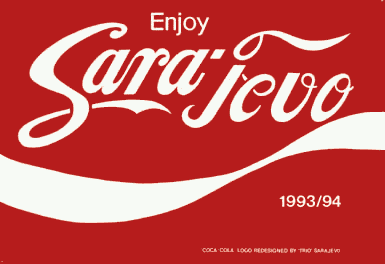
In 1985, three graduates from the Sarajevo faculty of fine arts formed the design team TRIO Sarajevo. The group created designs for bands, theatre companies and art and culture-based magazines.
“In April 1992 the Bosnian war began, and Sarajevo was besieged. Despite the obvious hardships of life in a city under siege for two and a half years, and although they had many opportunities to continue work outside Bosnia-Herzegovina, TRIO opted to remain in Sarajevo throughout the war. Faced with a market suddenly reduced to a 3km wide stretch of a city under siege, TRIO have nonetheless continued to earn a living as commercial designers, receiving payment for their work in food, cigarettes and (occasionally) small amounts of money. During the war TRIO have managed to assemble a computerised design office put together from various components which were borrowed or begged from friends and colleagues in Sarajevo.... In addition to their regular work, TRIO have also invested a great deal of time putting together a collection of graphic art aimed at raising awareness of the plight of their city throughout Europe. The work which has made them famous in western capitals is based on a series of reworkings of well-known advertising and pop-art images, such as the logos for Speilberg’s Jurassic Park, Coca-Cola, Absolut Vodka, Warhol’s famous Campbell’s Soup, and satirical adaptations of famous posters, such as Monroe’s Some Like it Hot, Your Country Needs You, Wake Up America!, Munch’s Scream, and many more.”
From The Design Group - TRIO SARAJEVO. The visual formula is direct and simplistic, but according to “Ironic Postcards from a City at War” the intent is to inject notice of the crisis into Western pop culture, to attach new associations to strongly recognized brands. My favorite is not one that uses the commercial brands, it is the stamp the group designed in 1995 with an image of one of destroyed post office buildings:
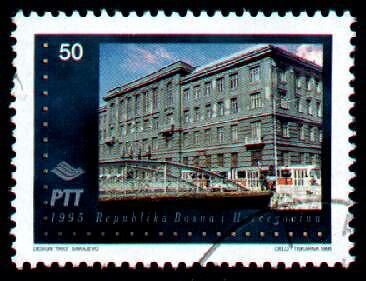
Found via OpenDemocracy


